Blue lizards live around the world. They are found in all types of habitats, from tropical forests to dry habitats.
These lizards can be partly blue or entirely blue. They may even be occasionally blue, as is the case with many juveniles.
In some species, males are the mostly multicolored lizard as females may be dull colored.
Table of Contents
Are Blue Lizards Poisonous or Venomous?
Blue lizards may be venomous or non-venomous. The venom of these lizards is not likely to cause any serious reactions in humans.
Some of the adverse reactions to eating these lizards have been documented in cats and dogs.
However, not all pets react to these lizards and most may not show any symptoms in case of short contact periods.
29 Types of Blue Lizards
Here are some of the most common types of blue lizards in North America and around the world.
1. Skinks
Skinks are some of the most common types of lizards in The United States. Their smaller legs may mean they look different, skinks are very similar to lizards. They even come in blue colors.
- Western Skink (Plestiodon skiltonianus) are some of the typical blue-tailed species of The United States.
These skins only show vivid blue tails in their juvenile days. The gray color is specific to their tails in adulthood.
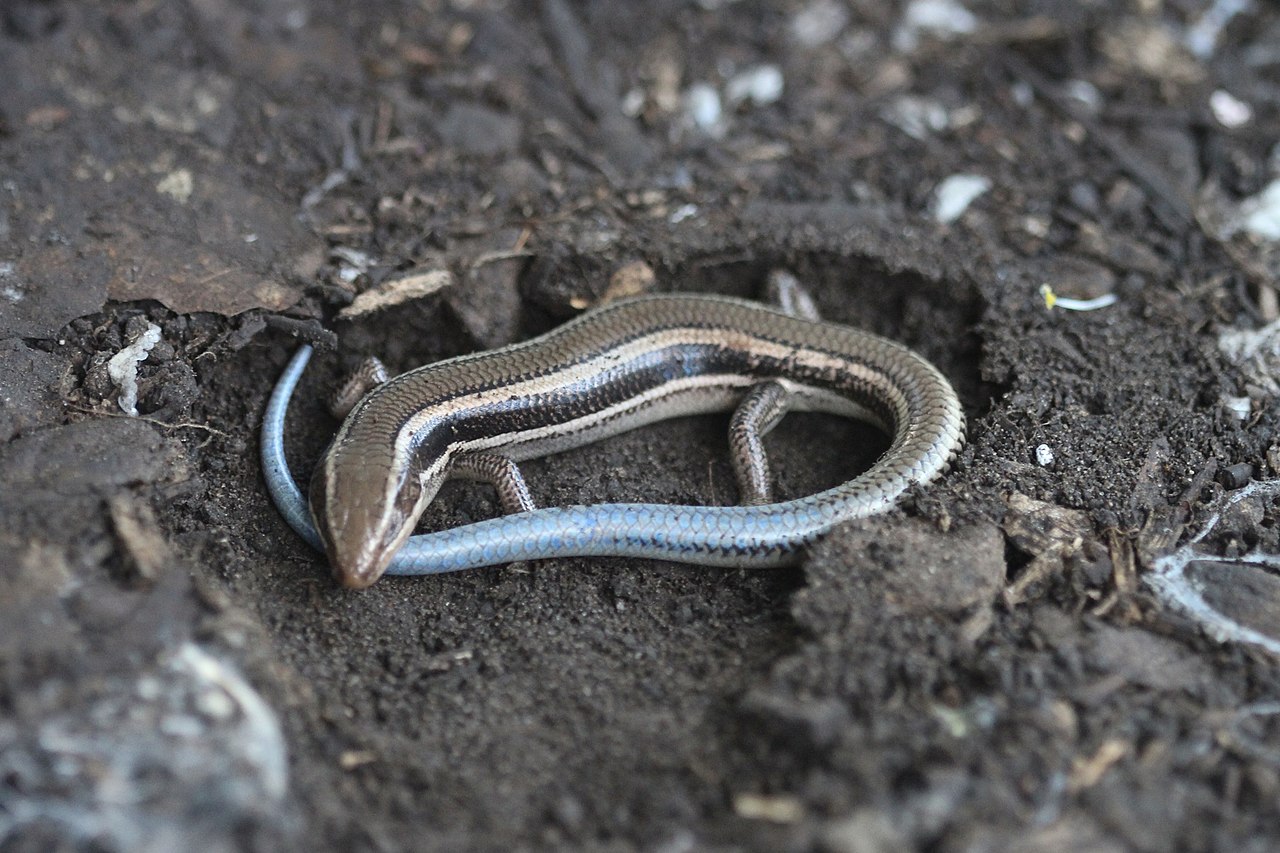
- Common Five-lined Skinks (Plestiodon fasciatus) also have blue tails. The vivid blue coloring is specific to the contrasting tail of the species.
These skins are dark brown or black with off-white stripes. The blue color of their tails also fades with age, especially in males.

- Mountain Skinks (Plestiodon callicephalus) are among the few blue-tailed skinks which show a blue tail color even in adulthood.
This species is mostly found throughout Mexico, New Mexico, and Arizona.
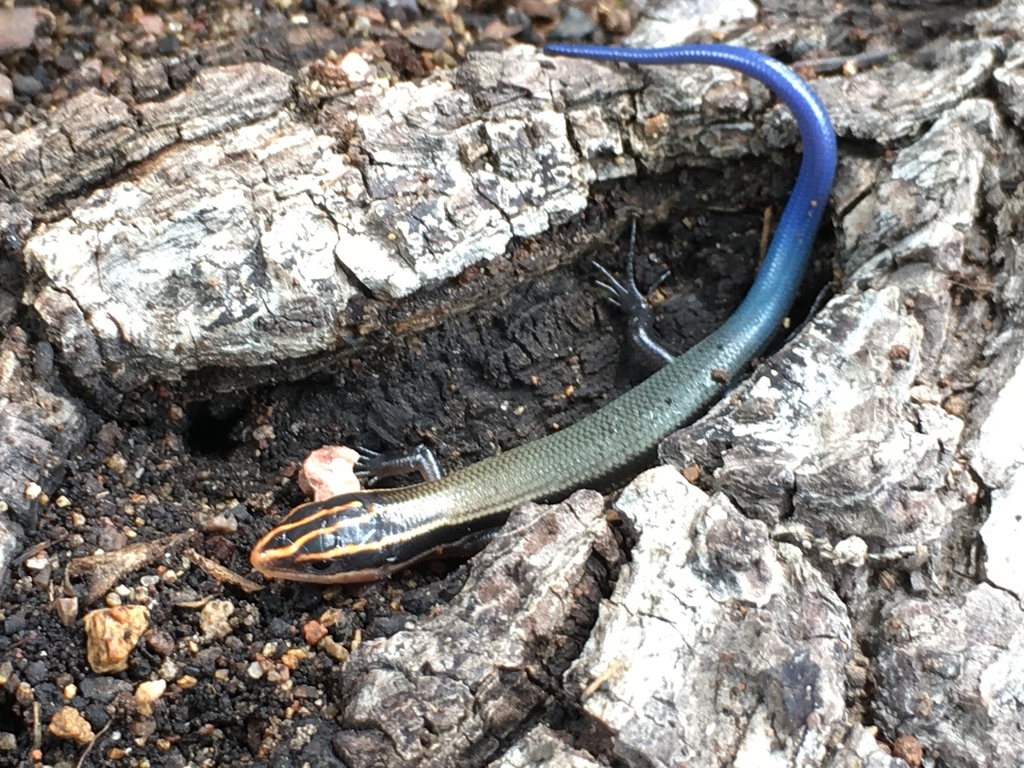
- Azure-tailed Skinks (Emoia impar) have azure tails. These light blue tail skinks are now established in Hawaii.
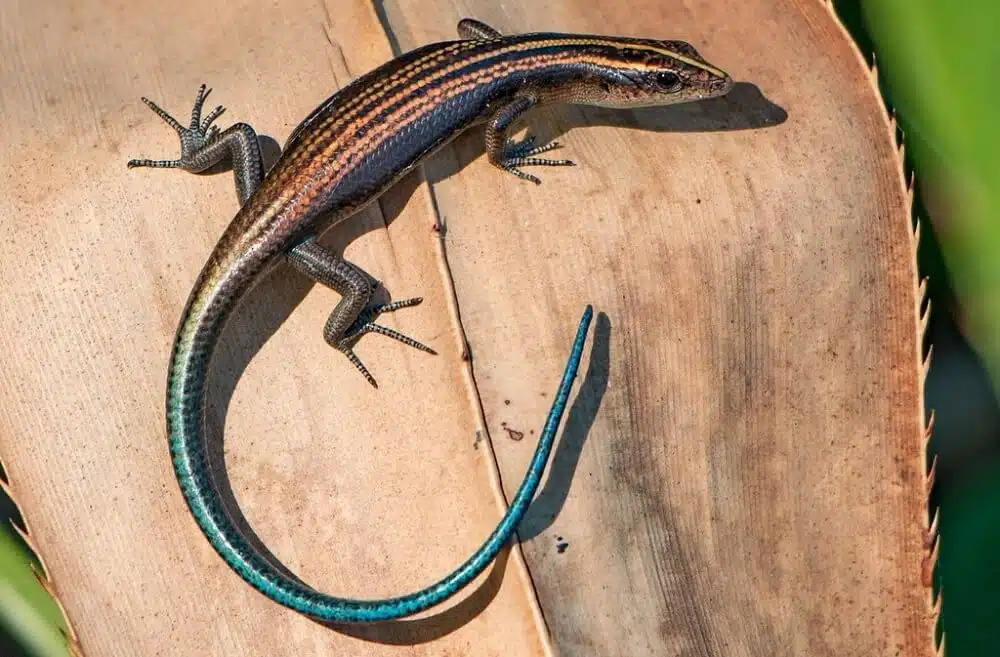
2. Eastern Collared Lizard

Eastern Collared Lizards (Crotaphytus collaris) are sexually dimorphic species. Males show a more colorful appearance compared to females.
Azure blue colors are specific to the body, tail, and legs of the male Eastern Collared Lizard.
A yellow and black neckband and a yellow neck separate the dull colors of its head from its azure body color.
Females are dark gray and brown. They show a pattern of white stripes along the body to better blend in.
3. Green Lizard

Green Lizards (Lacerta viridis) are European natives with small differences between males and females.
More colorful males have a blue face and neck while their crest and the rest of the body are mostly green.
Females show a white and brown head with a similarly-green body without any blue nuances.
Further differences include a striped tail on females.
Reaching a size of up to 16 inches, the males and females of the species also have different head sizes. Blue-headed males are larger than females.
Females also have slender bodies compared to wider-bodied males.
4. Blue-Green Smooth-throated Lizard

A small species of Chile, Blue-Green Smooth-throated Lizards (Liolaemus tenuis) grow to a size of up to 2.1 inches.
Males and females have different coloring. A blue tail is specific to the male which also shows blue hind legs.
The blue coloring of males may also continue on the lower side of the underbelly while the rest of their body is yellow-green.
Females are gray-brown. Some morphs of this species show a black and blue tail with an orange and black body.
Also known as The Thin Lizard, Blue-Green Smooth-throated Lizards are further identified by their slender frame, these types of lizard are active during the day.
5. Southern Tree Agama

Breeding Sothern Tree Agama (Acanthocercus atricollis) males are known to have a vivid blue coloring. Their heads and front legs may be completely blue or partly blue.
When partly blue, their heads are backed by green coloring while the rest of the body remains brown, yellow, and gray.
Females are known to have dull coloring, often taking on the colors of their environment.
They can be gray with white spots with a similarly-colored head and tails. The head and tails of males are mostly blue.
As an African native, these lizards are also different when it comes to the side neck colors which may be all-black on males.
6. Iberian Emerald Lizard

Shrubland and areas with vegetation around rivers are the main habitats of The Iberian Emerald Lizard (Lacerta schreiberi).
This is a species that lives in The Iberian Peninsula both in Portugal and Spain.
Much of its coloring is different between males and females. The male features a bright blue head.
Its bright nuance is close to azure and it’s speckled with black marks.
The body and the legs of males are mostly green with additional black marks and patterns.
Females of the species show a combination of green and black coloring with a yellow-green head and lack azure areas.
Juveniles are mostly dark gray to black with just a few yellow spots and yellow legs.
7. Minor Lizard

Numerous blue nuances are seen on Minor Lizards (Sceloporus minor).
Bright blue colors are seen across the species. Azure blue is seen on its back, belly, and legs. Additional brown patches are seen on its dorsal side.
A darker blue nuance with a metallic sheen is specific to the head of this lizard.
The tail of the species has the same bright blue nuance as the body but shows dark blue banding. A darker blue band is also visible on the mid-dorsum.
The dark blue head of these lizards may also come in purple morphs.
8. Little Striped Whiptail

Blue colors are more visible on the female Little Striped Whiptails (Aspidoscelis inornatus).
The female shows a blue ventral color both of its body and its tail. Female Little Striped Whiptails also have a blue neck.
Blue sections on the belly of males are smaller and not as easy to spot.
This species is mostly black and yellow dorsally, with a characteristic pattern of stripes.
Found in states such as Texas and Arizona, Little Striped Whiptails are a species of grasslands and arid lands. It can even be found in rocky terrains with reduced vegetation.
9. Kenyan Rock Agama
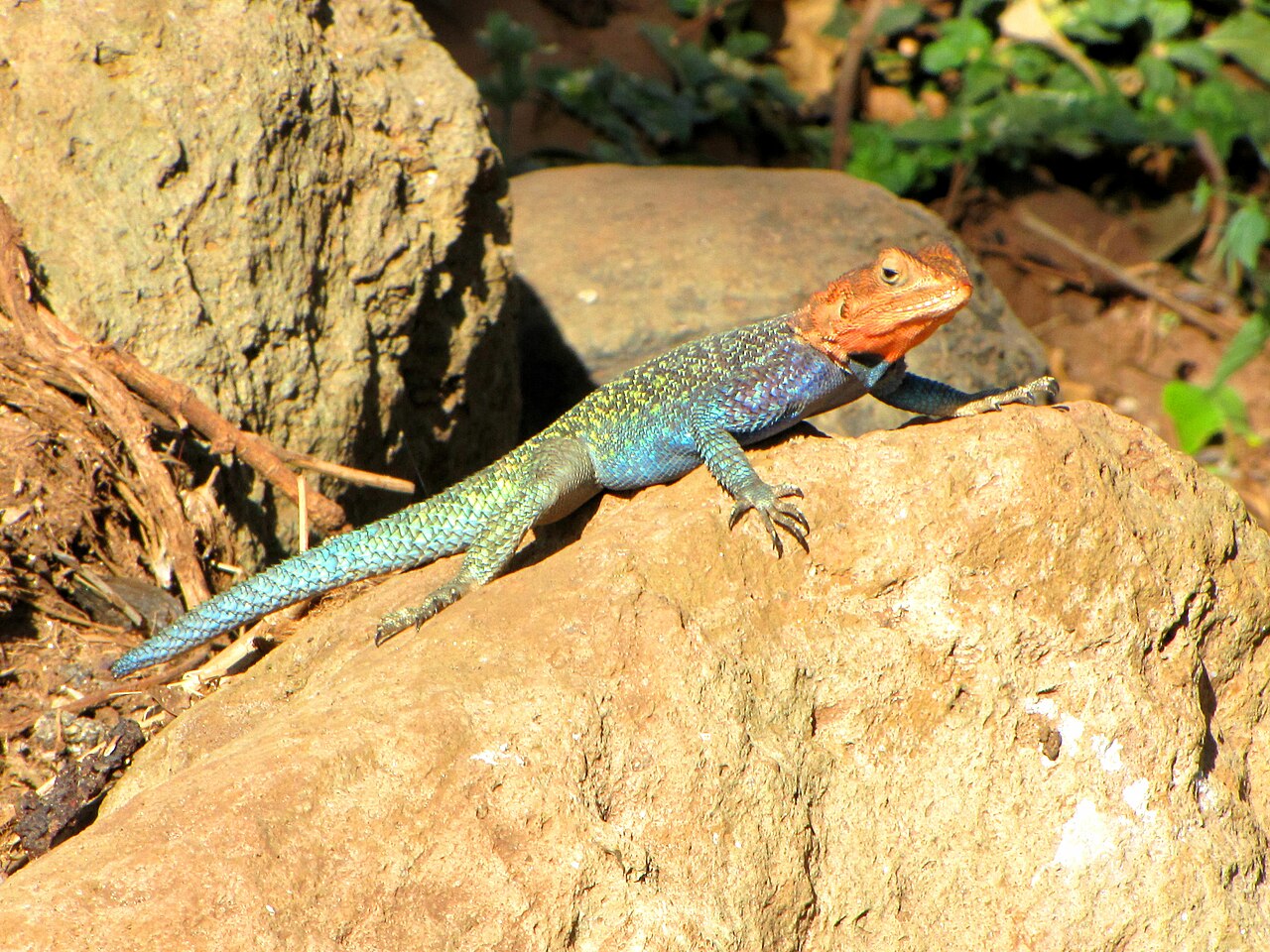
Light blue nuances are seen on Kenyan Rock Agamas (Agama lionotus). Males and females of the species show completely different coloring.
Males have bright blue underbellies with bright blue ventral tails.
The dorsal side of males is comprised of black and yellow color patterns while their heads are red. These red-headed lizards may also have orange heads.
Females have a black and yellow color with multiple white dots along the dorsum. They have a dark ventral color.
Lizards of this family are Kenyan natives with an expanded territory into Uganda and Ethiopia.
10. Siamese Blue Crested Lizard
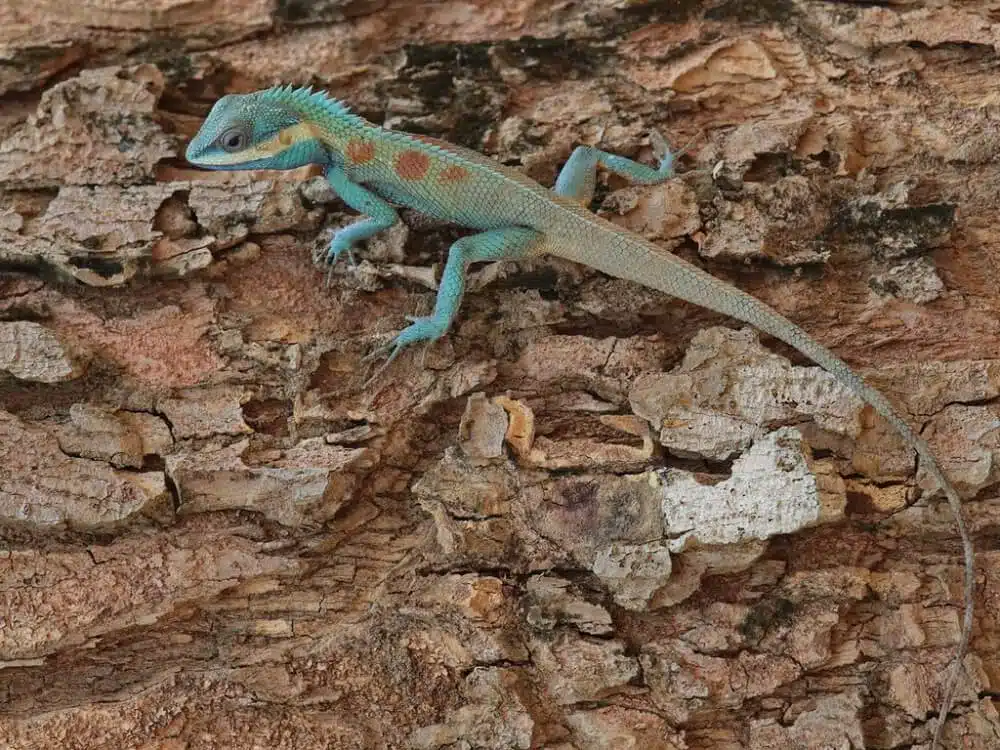
The Siamese Blue Crested Lizard (Calotes goetzi) is a species of Southeast Asia.
It lives in Thailand, Myanmar, and Singapore and features a dimorphic appearance between males and females.
Crested males are mostly blue. They feature a blue crest and a dark blue head with a darker blue nuance continued on their front legs and upper body.
A bright blue nuance is seen on its lower body, hind legs, and tail. The tip of its tail is already gray-brown, with just a few hints of blue.
Dark blue spots are seen along its body.
Females are black with large brown blotches. They blend in better when it comes to avoiding being spotted when laying clusters of white eggs.
11. Allison’s Anole

Feeding on small invertebrates, Allison’s Anole (Anolis allisoni) is a species seen during the day.
Females of the species are more difficult to identify correctly as they feature a pale green uniform color.
Males are much more colorful. They have a blue head with a bright blue neck. They also have a blue upper body with blue legs in the front.
The rest of the body of this species is mostly green, but generally a more colorful green nuances than the green of the females.
In some cases, even males lack the blue color of the head and legs. For example, Allison’s Anoles in Honduras have a dark green head.
12. Gaige’s Rainbow Lizard
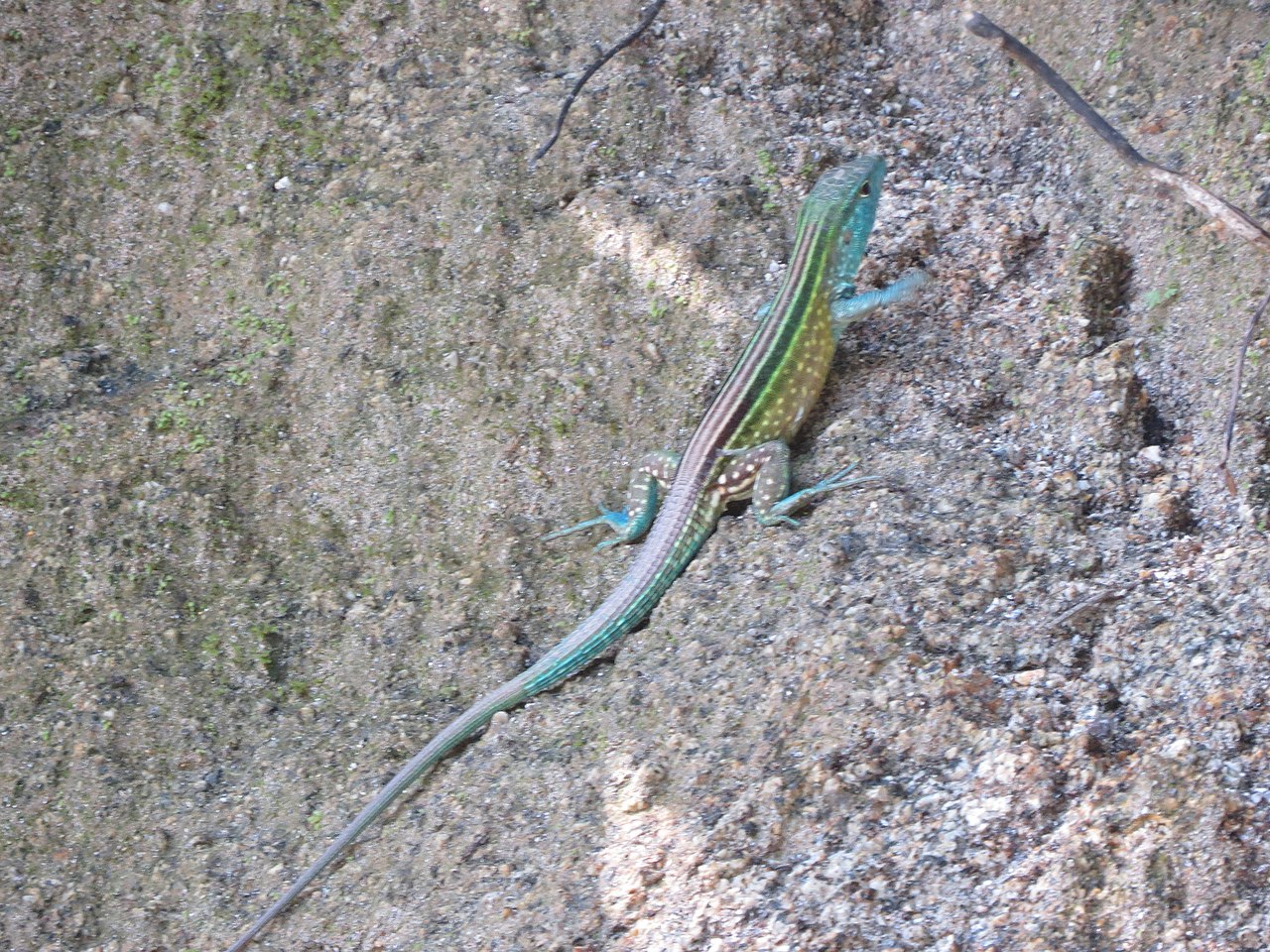
A Colombian native, Giage’s Rainbow Lizards (Cnemidophorus gaigei) are named after the multicolored appearance of males.
A blue face and neck are specific to males, together with a blue ventral color and partially blue front legs. Gray-brown dorsal coloring with white spots completes their appearance.
Faint black stripes are seen on their mid-dorsum.
Females aren’t as colorful. They are dominated by dark brown and black stripes and a dull gray tail color.
Some variants include more blue coloring on the ventral side and even green tails.
Ventral colors also vary from green to yellow nuances.
13. Aruba Whiptail

A special status is attributed to Aruba Whiptails (Cnemidophorus arubensis) in Aruba. These are the most common lizards on the island.
Blue nuances and patterns are specific to Aruba Whiptails.
These lizards have dark bodies and azure tails with matching azure spots on the sides of the body and on the dark legs.
Gradient blue nuances are specific from the tail to the head. Blue sections closer to the head are darker compared to the azure nuances of the tail.
Females are darker and may have blue-green nuances in different patterns across their bodies and legs.
14. Common Flat Lizard

Most of the 9 subspecies of Common Flat Lizards (Platysaurus intermedius) are at least partly blue. From blue bellies to blue throats, these species are mostly blue ventrally.
Found across multiple countries, these lizards have different color patterns from one sub-species to another.
A multicolored lizard, The Common Flat Lizard is a species with a dark blue head and a brighter blue upper back next to the head and neck.
Dorsal colors vary but are generally bright. Yellow and mustard nuances are combined with black leg coloring on the subspecies of this lizard.
An African native, these types of lizards live next to or right under large rock formations.
15. Guatemalan Emerald Spiny Lizard

A blue-green lizard, Guatemalan Emerald Spiny Lizard (Sceloporus taeniocnemis) lives in Guatemala and Mexico.
Dark blue nuances are specific to their tails. Green and black nuances are combined in their iridescent body color.
A green-yellow head completes the multicolored appearance of the species.
Females aren’t as colorful as the blue-tailed males. They are mostly green with olive nuances dominating their appearance.
Black sections are also seen on the dorsal side of females which have cream ventral coloring.
16. Grand Cayman Anole

Male Grand Cayman Anoles (Anolis conspersus) are almost completely blue. Bright and dark blue colors are specific to these males.
Their dewlaps are mostly dark blue while the rest of their bodies are blue-green.
Additional green spots are seen on the neck while the spots next to its tail are mostly blue.
Females and juveniles are dark brown to purple. They lack blue nuances and may blend in with the trees they climb better than males.
A native anole of The Grand Cayman, the species is most active in May.
17. Vietnamese Blue Crested Lizard

A species of Thailand and Burma, The Vietnamese Blue Crested Lizard (Calotes bachae) is known for its blue nuances.
Males have a bright blue head and a partially blue dorsal crest.
Dark blue necks are seen on males which also show a bright yellow band along the eyes.
The rest of the body and the legs have a green-olive color with a similarly-colored crest.
Females are darker and have a brown-gray appearance. Dark brown nuances are specific to its body.
This arboreal species has a long banded tail and may also have a yellow body variation in the case of males.
18. Southern Crevice Spiny Lizard

Mostly spotted from April to November, Southern Crevice Spiny Lizards (Sceloporus aureolus) are native to Mexico.
A multicolored appearance based on blue nuances is specific to these lizards.
The species has azure ventral coloring of the tail. It also has an azure neck and hind legs. Its belly has a dark blue appearance.
Navy blue coloring is specific to its neck.
Its dorsal appearance is also multicolored. Its head is gray while white, black, and gray nuances are specific to its back.
19. Black-green Smooth-throated Lizard

Native to Chile, Black-green Smooth-throated Lizards (Liolaemus nigroviridis) are also partially blue.
Males show blue nuances along the body and tail.
Mostly black, males have contrasting bright blue spots along the head, back, and tail.
Females show varying coloring with shades of brown, tan, and yellow. Some female morphs may also show blue spots around the head but to a lesser degree compared to males.
20. Laurent’s Whiptail

Smaller than the female, the male Laurent’s Whiptail (Cnemidophorus murinus) is a lizard with bright blue patterns.
Native to Curaçao, the slender lizard has a bright gray body with an azure tail.
Blue spots are also seen along its body, up to its head. These have a pale azure color and almost appear white.
Females are wider and larger. They are dominated by dark brown colors with tan or dark yellow spots on the dorsum.
21. Uganda Blue-headed Tree Agama

Dark blue nuances are partly characteristic of The Uganda Blue-headed Tree Agama (Acanthocercus ugandaensis).
This is a species that has a dark blue head and a dark blue tail.
A large arboreal lizard, Uganda Blue-headed Tree Agamas has a bright tail base and a bright body close to the tail.
The body part closer to its head is also dark blue, as are its front legs.
Common variants include bright blue lizards with a similar color pattern.
The lower body part of the lizard varies in color and is adapted to the appearance of its most common habitat.
22. East Arabian Desert Agama

A Middle-Eastern species, The East Arabian Desert Agama (Pseudotrapelus jensvindumi) is a species with blue colors.
Male lizards have a dark blue-emerald color. They have a uniform blue tail with a blue head, blue legs, and a mostly blue back.
Gray-tan color patterns are seen across its dorsum.
Females are only blue at the back of the head. They are dull-colored and have various earth nuances which considerably improves their camouflaging abilities compared to males.
23. Vivid Blue Rainbow Lizard

A color-adaptable species, Vivid Blue Rainbow Lizards (Cnemidophorus espeuti) are native to Colombia.
The South American lizard shows a dark blue base nuance with purple undertones and a bright mid-dorsal stripe.
The head, tail, legs, and much of its body are all dark blue.
Common morphs of the lizard include green, gray, and brown colors.
In the rainforest, this species also appears in an almost completely blue color with small dorsal green areas, mainly as a response to its dense vegetation habitat.
Multiple morphs of this species are also found on Providence Island in The Caribbean.
24. Bluetail Day Gecko

Blue or blue-green colors are specific to the male Bluetail Day Gecko (Phelsuma cepediana). This is a species where females look completely different, mostly green.
A native to Mauritius, Bluetail Day Geckos are a diurnal species with dark blue to purple dorsal coloring.
This is a species that may or may not show additional red spots on the dorsum.
Male Bluetail Day Geckos have multiple dorsal spots compared to the spots on the dorsum of females.
Furthermore, while they are blue, these lizards have green legs with a partial blue undertone which are also spotted if the dorsum of the male is also spotted.
25. Myanmar Blue Crested Lizard

An Asian lizard, Myanmar Blue Crested Lizards (Calotes mystaceus) are found in multiple countries in Southeast Asia.
It features a bright blue or blue-green color.
This is one of the multiple crested lizards of the region. Its crest is mostly bright blue, as are its head and front legs.
The additional blue coloring is specific to its ventral side.
Its tail and the body section close to its tail are mostly yellow to tan. Dark yellow spots are seen along its tail as well as on its mid-dorsum.
This non-venomous lizard is a constant presence in Myanmar, India, Cambodia, and China.
26. Common Painted Smooth-throated Lizard

Different shades of green and blue are specific to The Common Painted Smooth-throated Lizard (Liolaemus pictus).
This is a species with a bright blue color on the ventral side with a striped green and brown dorsum.
Some morphs of this species are black, yellow, and green, without blue sections.
The capacity to adapt to its environment means The Common Painted Smooth-throated Lizard also has a bright blue tail.
Females of the species are dark, typically brown or black.
27. Rainbow Whiptail

A South American species, Rainbow Whiptails (Cnemidophorus lemniscatus) are named after their striped multicolored appearance.
These are types of lizards that can camouflage themselves in different shades of green and blue.
Green and blue colors make up the dominating appearance of the species.
Bright blue morphs have azure tails and necks. They have bright green lateral bodies and dark green dorsal coloring.
Dark blue morphs come with white or bright green mid-dorsal coloring.
A species that grows to 12 inches, Rainbow Whiptail can reproduce both sexually and asexually.
28. Ibiza Wall Lizard

Green, blue, and black irregular stripes are seen along the body of The Ibiza Wall Lizard (Podarcis pityusensis).
This is a species with bright blue colors on the head and the sides of the body.
Even more, some morphs of The Ibiza Wall Lizard can be mostly blue. A bright blue body, a blue-purple ventral side, and a bright blue head are specific to this morph.
These types of colorful lizards take on the colors of their habitat.
Some of the most remote populations of the species live next to tall rock formations such as those on the small Mediterranean island of Es Vedra.
29. Abbott’s Day Gecko

Emerald green with blue undertones is specific to the male Abbotts’ Day Gecko (Phelsuma abbotti).
This species lives in some of the most remote humid forests in the world, such as those in Madagascar.
It shows a diurnal activity level and the capacity to match its appearance to its habitat.
While some Abbot’s Day Geckos can be mostly green-blue, others are mostly gray with dark blue coloring on the dorsum.
Its Assumption Island Day Gecko is the gray morph with clear dark blue patterns on its dorsum.